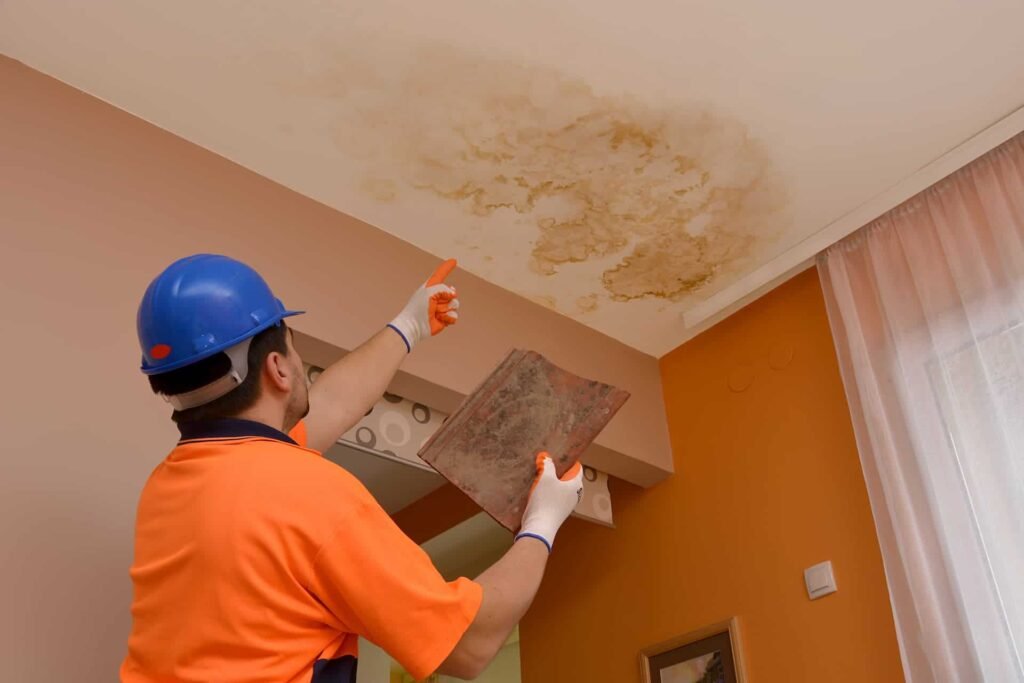A small roof leak does not look scary. It might show up as a faint spot on the ceiling, a tiny drip after a hard rain, or a bit of paint that looks puffy. It seems simple to put a bowl under it and move on. The problem is that water never stays put. It sneaks into places you cannot see, and over time it quietly turns small damage into big damage.
Where the Water Actually Goes
Roofs are a stack of layers. There are shingles on top, then a water barrier, then wood sheathing, then the attic. When water slips past the outer layer, it follows the easiest path. It can run along nails, slide across wood grain, and soak into insulation. It often travels sideways before it goes down, so the wet spot on the ceiling may be far away from the real leak. That is why guessing the source is hard.
Inside the attic, water can drip, but it can also cling to boards and spread out. It may not leave a puddle right away. It might only raise the moisture in the wood. That slow, damp state is where trouble starts. Wood that stays damp swells and softens. Metal parts, such as nail heads and hangers, can rust. Once rust bites in, parts lose strength, and joints start to shift.
Getting Clear Info Without the Sales Pitch
Some people want a simple overview before they decide what to do. Reading what standard services cover, and how repairs are explained, can help set fair expectations. For a straight, no-frills look at common fixes and inspections, browsing trusted roofing repair companies can be useful for understanding terms and typical steps without turning it into a sales call.
The First Signs Most People Notice
Ceilings often tell the story first. A light brown ring can appear and grow a little wider after each storm. Paint can bubble or peel. Sometimes there is a faint musty smell in one room. Around vents or chimneys, shingles may look curled or slightly lifted. Granules in the gutter show that shingles are wearing down. None of these clues scream danger on their own, but together they point to water getting past the surface.
Inside the attic, insulation tells another part of the story. Fiberglass should be fluffy. When it gets wet, it clumps and packs down. Packed insulation traps heat in the wrong places. In summer, rooms feel hotter. In winter, heat escapes faster. That means higher power bills even when the leak is small.
How a Tiny Drip Becomes a Big Problem
Water is patient. It finds small gaps, then makes them bigger. A drip near flashing can weaken the seal, so the next storm pushes more water in. Wood that swells can press against nails, which lifts a shingle edge, which invites even more water. It is a chain reaction. What began as a faint stain becomes a wide soft spot.
Another problem is hidden mold. When a surface stays damp for days, tiny spores in the air settle and grow. At first it looks like a light dusting on wood or paper. Given time, it spreads across the back of drywall or the surface of the sheathing. Once it reaches the room side of the ceiling, the smell is stronger and the stain spreads faster.
Why Mold Is More Than a Mess
Mold thrives in dim, damp places. It feeds on paper facing on drywall and on the tiny bits of wood fiber in the attic. When it grows, it releases tiny particles into the air. People with allergies can feel it first, with sneezing and itchy eyes. Babies, older adults, and anyone with breathing problems can feel worse in a home where mold has time to spread. The fix gets harder when it reaches living spaces, because parts of the ceiling may need to be cut out and replaced.
Electrical Risks You Can’t See
Water and electricity are a bad match. A slow leak can drip onto a junction box in the attic or run along a wire toward a light fixture. That can trip breakers, but it can also cause corrosion at contacts. Corroded connections run hot, and heat around wiring is never safe. This is one reason a “small leak” should not be ignored for months. The ceiling below a wet attic light can also become soft. That is why a light that flickers after storms needs attention right away, not just a new bulb.
Pests Follow the Moisture
Damp wood attracts pests. Termites and carpenter ants prefer wood that has begun to soften. Roaches love damp corners. Once insects move in, they create new paths for moisture by chewing and tunneling. That makes the original leak worse and spreads the damage across a wider area. Fixing the moisture stops the party for pests and keeps repair work smaller.
The Roof Structure Can Shift
Roofs are designed to carry weight in a certain way. Rafters and trusses spread the load to the walls. When water weakens key spots, that balance changes. A rafter with a long, damp stain can twist a little. Nails lose their grip in swollen wood. Over time, the roof line can dip. You may notice shingles that look wavy, or a valley that seems to sag. That is the stage where repairs are no longer cheap, because structure work is slower and needs careful planning.
Why Florida Weather Makes It Worse
In Tampa Bay and many coastal areas, heavy sun, sudden rain, and strong wind take turns beating on roofs. Hot sun makes shingles expand. Fast rain cools them down. Wind lifts edges. Salt in the air can speed up corrosion on exposed metal. A small gap from a past storm can be fine for a while, then a summer downpour pushes water through that gap all at once. That is why a tiny leak during spring can be a soaked ceiling by late summer.
Paint and Drywall Do Not Like Water
Ceiling paint hides a lot, but it cannot hold forever. Water breaks the bond between paint and the paper on drywall. First the surface dulls, then it blisters. When the bubble pops, the paper tears and droops. Drywall loses strength fast when it is wet. It can sag between joists and crack along seams. Once that happens, even a perfect roof repair still leaves a ceiling patch job. Catching leaks early prevents the inside finish from reaching that point.
Gutters, Valleys, and Edges Matter
Some leaks start because water cannot drain the way it should. Clogged gutters make water pool along the edge of the roof. That standing water can creep under the edge shingles. Valleys, where two roof planes meet, carry the most water during storms. If debris sits there, water slows down, and the extra time gives it a chance to find a weak point. Keeping water moving off the roof is a simple way to stop several common leak paths from opening up.
Cost Grows With Time, Not Just Size
People often wait because the drip seems small. The cost does not grow in a straight line though. Early on, a repair might be sealing flashing, replacing a few shingles, and drying a small spot. Months later, the same area could need new sheathing, new insulation, drywall work, and paint. Add mold cleaning or electrical fixes, and the bill climbs faster. Time is the real cost multiplier for roof leaks.
When a Ceiling Stain Means More
A stain that changes shape or gets darker after every storm means the leak is active. A stain near a bathroom fan can be a roof issue or a vent problem. A stain near a chimney points to flashing. A stain down a wall can be from water traveling along framing and then showing up lower. Patterns matter. Watching when and where the stain grows can help point to the real source.
Key Takeaways to Keep in Mind
A small roof leak is not harmless. Water moves in hidden paths, weakens wood, rusts metal, and feeds mold. It finds wiring and light fixtures, and can make ceilings sag. In stormy places, weather pushes tiny gaps into bigger openings fast. Insulation that gets wet stops doing its job, and energy bills rise even when the thermostat does not change. The sooner water is kept out and the wet area is dried, the less has to be replaced later. Paying attention to early signs protects the roof, the rooms under it, and everyone who lives there.

